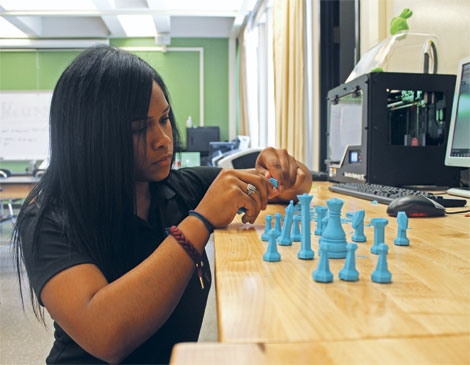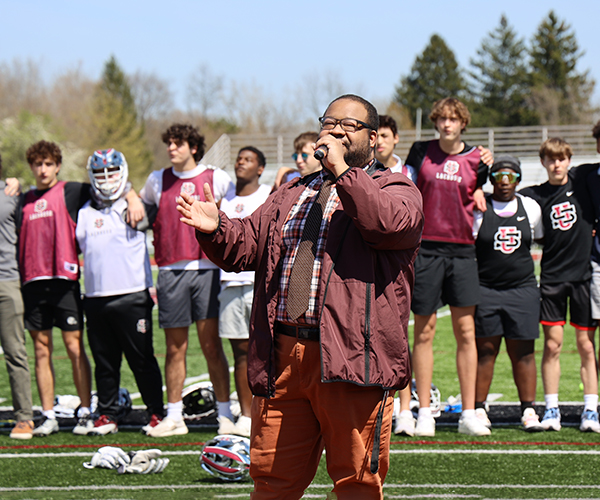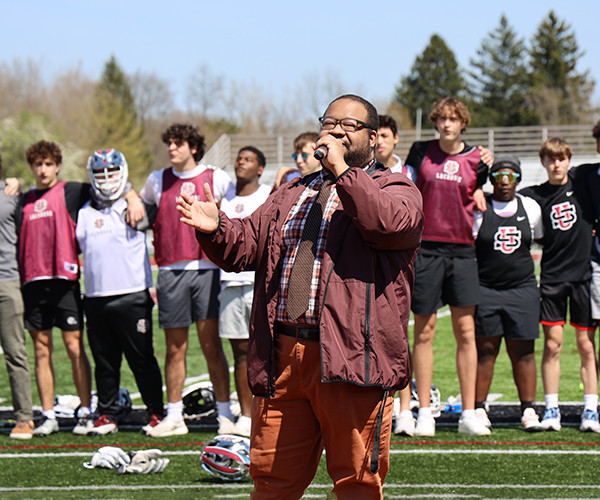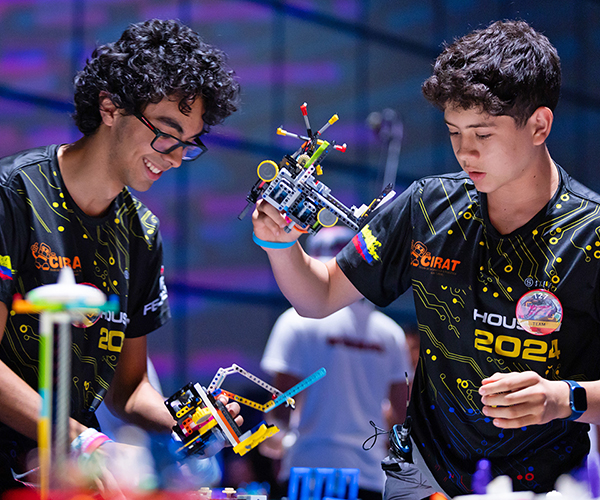Andrea Lane's perfectly manicured nails seem out of place as she changes a drill bit on a ShopBot router used for cutting wood and metal. But then she reveals how she single-handedly installed the whole thing — the largest machine in the Fabrication Laboratory she manages at Cleveland State University, which is shared with the MC2 STEM High School.
Moments later, Lane walks across the room and pulls a tiny blue plastic alligator off the 3-D printer. As she begins peeling away its hardening base, her nails catch the light and glitter.
When asked how someone who does such hands-on work can keep a manicure so perfect, she laughs. It was a rare treat before a trip to Spain at the end of June to make a presentation at the Massachusetts Institute of Technology's International Fab Lab Conference in Barcelona. That trip was sponsored by the Teaching Institute for Excellence in STEM education based in Cleveland Heights, where she serves as a FabLab fellow.
In fact, Lane, of Bedford, quickly rattles off four titles at different organizations all having to do with FabLabs and science, technology, engineering and math education.
"I guess just saying 'I'm a FabLab guru' would work for all of them," admits the 20-year-old junior majoring in mechanical engineering at Cleveland State.
At 15, Lane was part of the inaugural class at MC2 STEM High School, part of the Cleveland Metropolitan School District, when her assistant principal saw a passion in her and started letting her out of class to give presentations to other teachers. "They were like, I'm not listening to this little girl tell me how to teach my class," she says.
But since MC2 STEM High School built the first FabLab inside a high school, no one knew more about the equipment than Lane, who spent every free minute there.
True FabLabs have a variety of equipment, from large computer-controlled machining devices to 3-D printers to Lane's favorite: a vinyl cutter that makes decals she has displayed on whiteboard painted walls and in the school's hallways. But, FabLabs — also occasionally called Makerspaces — are growing in popularity thanks to the affordability of 3-D printing, which heats and melts plastic from a spool and lays it down one layer at a time in a preprogrammed pattern.
The emerging technology is suddenly the "it" thing in education. President Barack Obama mentioned 3-D printing in last year's State of the Union address. And MakerBot, a 3-D printing company, has launched an initiative to put the device in every school in the country.
Lane now takes the Great Lakes Science Center's Mobile FabLab — a 65-foot trailer equipped with a CNC mill, laser cutter, 3-D printer and more — to schools throughout Northeast Ohio and surrounding states. Recently, she decided to open the CSU space she manages to the public every Saturday from 10 a.m. to 4 p.m. (People need to bring their own materials and computer.)
She believes the critical thinking, problem-solving and creative skills learned in the lab are valuable no matter what your eventual college or career path. "It gives you the background and knowledge to be able to dissect a problem in an engineering way," she says. "You're able to visualize it."
•••••
Many schools throughout Northeast Ohio have recently begun integrating 3-D printers into the classroom.
Hathaway Brown School, an independent girls' school in Shaker Heights, received a 3-D printer last winter. With a long history of providing hands-on tools for girls, such as woodworking machines, Hathaway Brown students were eager to try the new technology.
The school's robotics team, nicknamed the Fighting Unicorns, used the 3-D printer to design and print practical parts for its robot, including plastic casings to shield a camera and plugs to protect sharp parts.
But the girls also had fun with it, creating hot pink plastic unicorn mascots.
That's part of the attraction for educators: The sometimes vague concepts of math and science come alive in cool, full-color reality.
"You're working with a three-dimensional object, but first you're looking at it on a flat screen," says James Allen, Hathaway Brown's upper school technology department chair and director of the Center for Technology and Invention. "So there's a certain amount of visualization and spatial awareness that is required."
Ed Holmok, who teaches Project Lead the Way engineering classes at West Shore Career-Technical District at Lakewood High School, believes the cool factor in 3-D printing actually leads to kids working harder.
"Once kids know that they're going to print this thing, they put a lot of effort into it," Holmok says.
The motivation is so much greater than creating a computer model, he says. For example, when one student wanted to print a tiara, her friend spent hours after school secretly designing and printing the perfect one out of glow-in-the-dark plastic. When she finished, the class held a coronation ceremony, even borrowing a choir robe for the queen, and presented the tiara.
Beaumont School is adding extra motivation for its students by building an entire STEM wing to emphasize the importance of creativity, design and problem-solving. The 10,000-square-foot addition, expected to be complete in December, will house eight new classrooms and new student commons.
But the independent girls' school in Cleveland Heights isn't waiting to implement the technology. After a parent donated a 3-D printer, science department chair Lauren Brandon spent the summer brainstorming ways to use it in pre-engineering and entrepreneurship classes.
"It's the critical thinking," she says. "Taking ideas, synthesizing them, creating something new, problem-solving. Design, creativity, evaluation — those are types of things that all come into use when you're creating something. All those are higher level thinking skills, and that's what transfers so well into college and careers."
Lawrence School, which specializes in students with learning differences, will begin using its new 3-D printer this fall in the after-school Maker Club that upper school technology director Sally Garza oversees.
When the Biology 2 class won $2,000 for a video on concussions and brain health, the students voted to use the money toward a 3-D printer and scanner.
And Garza already has ideas for how to pay back the department's generosity.
"Our biology teacher has a lot of animal skulls," Garza explains. "They're too delicate for students to actually touch and look at closely. This will allow us to scan them in, reprint them in plastic, and the kids can actually touch those things."
Garza would also like to print every tiny bone in the human hand and have students work to put it back together. She plans to try out abstract ideas, such as creating a glucose molecule, as well.
"It's different from seeing it in a picture," Garza says. "If they can touch it and feel how things are connected, it triggers a whole different part of the brain."
•••••
While 3-D printing is an attractive learning tool, integrating the technology into a curriculum can be tough for schools, says Lane.
The printing process, for example, is slow. "Once they get it, they realize they can't get 30 pieces out in an hour class," she says.
The small alligator Lane created took about 30 minutes to print. In another machine nearby, printing the bust of a woman takes about 45 minutes. Both were simple test patterns. Prototypes for products or complicated parts can take hours.
The current technology works much like a hot glue gun, melting plastic from a spool and laying it down one layer at a time in a preprogrammed pattern. Some believe that ultimately every home will have one. Eventually when something breaks, you may be able to find the part on the Internet, print it out and get your dishwasher or dryer running again without needing a repairman. But that's a futuristic view.
As it stands, John Carroll University adjunct professor John Milam has worked with individual teachers integrating 3-D printing into classrooms for geometry and spatial reasoning projects but has not yet put it in his own curriculum to teach future educators about 3-D printing.
Technology alone doesn't make a teacher a better teacher or a student a better student, he emphasizes.
"It's not just the printer," says Milam, interim director of John Carroll's Center for Math and Science Education and Technology. "It's that the printer now allows a certain pedagogical approach that's adding to the success to the classroom."
For Lane, that means encouraging the teachers to let go of their old ways. Rather than standing in front of the class delivering information, such technology can be a liberating way for students to learn and explore alongside them.
"It's OK not to be the dictator," she says. "There's more than one way to solve
something."
As an educational tool, 3-D printing provides the opportunities for figuring out problems and allowing kids to fail, says Matt Falk, pre-engineering department chair at St. Edward High School in Lakewood.
In fact, St. Ed's puts so much emphasis on hands-on learning that it has four 3-D printers, including one bought more than five years ago when they were the size of a refrigerator and cost about $50,000.
Today, consumer-grade printers run from $1,000 to $2,000 and a plastic spool costs about $50 — comparable to printer ink. St. Ed's bought its most recent printers from Beachwood-based MakerGear.
Falk encourages trial and error, even when he sees a mistake. "I say, 'Let's print it and see what's going to happen,' " he says. "At worst it wastes maybe a dollar worth of plastic, but the experience that they get from seeing, Oh, that's what went wrong! I think that's worth more than a dollar."
Yet failure can be an easier adjustment for kids than teachers, says Lane. "With the engineering design process, you're supposed to fail. It's not designed for you to have it right the first time," she adds. "When you fail, you're learning how to problem-solve."
From that failure, Falk says, the students learn the importance of precision in design. For example, he assigned one class to design and print phone cases. Many just found cases online and printed those, something he discouraged. But one student took precise measurements and designed a case that fit his phone perfectly — only to discover it covered up the power button — and he had to do a redesign.
"I would much rather have the kids make their own," he says.
University School places a similar focus on the mechanics of creation in its art program, says Michael Starinsky, chair of the art department.
"We've maintained all the manual art skills: the darkroom for photography, furniture making for the woodshop; hands-on woodcut printing," Starinsky says. "When schools jump ahead and just dive into digital technology without those foundations, it's not necessarily bad, but you're only getting half of the whole picture. It's sort of like teaching high-level literature without understanding how to read really well."
•••••
While many high schools are implementing 3-D printers, Akron Public Schools will have one in six of its seven middle schools as part of its Gateway to Technology program by later this year.
"It's amazing how incredibly inventive students are, especially at that age because they're not inhibited," says Bob Conley, a consultant who works with the Gateway program. "They don't believe it can't be done."
Conley gives the students real-world challenges as if they're working at a global engineering firm. In one exercise, each school designs a shape in a software program called Autodesk Inventor that will fit into a shape from another school.
But they can only communicate between schools electronically, sending diagrams, sketches and pictures. When the shapes are printed, they must fit together.
Later this year, he plans to have the teams create a part for a remote-controlled car's suspension and steering. "I'm going to make sure that each school 3-D prints in a different color, so we'll know the part that doesn't work," he explains. "It's all about that kind of engineering."
These types of collaborative challenges give kids skills beyond the hands-on engineering and prototyping, Conley says. For example, they can use different management styles, by allowing one student to be a leader or having everyone get an equal vote on how to tackle the design.
"Critical thinking comes from analyzing the other groups," he says.
Akron's National Inventors Hall of Fame STEM Middle School has integrated 3-D printing into other classroom curriculum. Traci Buckner, director of specialty programs for Akron Public Schools, says last year's eighth-graders downloaded and printed a model of Abraham Lincoln's death mask before a trip to the Smithsonian in Washington, D.C. Then, they visited the real one.
"This year, they need to think of a way to improve something that they see or do throughout the school day," Buckner says. "They will draw up their design and create a 3-D model of it to be tested."
At Laurel School in Shaker Heights, art teacher Catherine Butler has used the 3-D printer with students in fifth grade, the year the school gives the students personal Chromebooks to work on.
She asks them to create an object they've never seen before. "This way, they can play with the shapes and make something that looks cool," Butler says. "It ties in with their math, geometry and basic computer literacy skills."
Students spend time playing with shapes in the program, stretching them or changing height and depth or connecting shapes to other shapes. The range of printed shapes varies greatly from something perfectly symmetrical to some so intricate they look like little landscapes, she says.
One drawback of 3-D printing is that although you can see multiple colors on a computer screen, the printer only creates the object in the color of the plastic on the spool.
So, Butler often has students print the shape in white plastic that can be colored with acrylic paint or markers, enhancing the students' ability to develop creativity.
In fact, Laurel uses the term STEAM, not STEM — with the extra "A" standing for "art" as an integral part of learning.
When it's not in use in an art class, the 3-D printer is part of Laurel's new Collaboratory — a room filled with tinkering and design materials and technology used to enhance the STEAM philosophy.
•••••
Andrea lane walks back to the 3-D printer and takes a bright green bust of a woman off it. She explains that 3-D printing is an additive process — the machine adds one layer at a time to build the plastic item.
A few machines down, she demonstrates a subtractive process with a laser cutter. She puts in a piece of solid wood, programs the computer and the machine cuts slits in a pattern so that the wood bends and curves in what she calls a "living hinge."
It's impressive. But Lane's got even bigger plans, inspired by the possibilities of the lab.
After graduating from Cleveland State, she hopes to take her knowledge and build a home that is fully sustainable on wind and solar energy — and contributes power to the nearby community — in North Carolina or maybe, after her trip this summer, in Barcelona, Spain.
"I drew up the blueprints in high school," she says.
SPLASH COURSE
CORE VALUES
We set out to answer the most frequently asked questions about the Common Core.
Lisa Lenhart was making small talk with another mom who asked for her thoughts about the Common Core. "What we're hearing," the woman told her, "is that they're dumbing things down for our students."
But Lenhart, an education professor and the director of the Center for Literacy at the University of Akron, had just witnessed a teacher in another school district struggling to implement the standards within her classroom.
"This teacher was so overwhelmed because for her class, the Common Core standards were so rigorous," Lenhart says.
How can the same exact standards be perceived as too hard for some and too easy for other classrooms? Who is right? We set out to answer some of the most common questions about the Common Core.
What is the Common Core?
In June 2010, Ohio adopted the educational standards, as have 45 other states and the District of Columbia. The objective is for children graduating high school to be "college and career ready."
The Common Core outlines standards at each grade level from kindergarten through high school in English language arts and literacy, and math. Other subjects, such as understanding the texts in science and social studies, are covered as part of the English language arts. However, Ohio has spelled out additional standards specific to those subjects.
In general, the Common Core's goal is to help children develop higher-level critical thinking skills rather than rote memorization and regurgitation of facts that are easily accessible on the Internet today. In addition, the standards aim to establish consistency in educational expectations from state to state, so that children who move don't fall behind.
Is the Common Core expecting too much from — or dumbing down — my kids?
"The standards are attempting to create a more level playing field," says Kathleen Roskos, professor of education at John Carroll University. "There are kids who are disadvantaged, but by not trying to bring them up, we only disadvantage them more for college and career readiness."
Because of the consistent expectations across state lines, some perceive that the standards dictate exactly how an instructor must teach a class, thus the rumors of dumbing down in some districts.
Lenhart, who supports the standards, is concerned by the approach that all American children should reach the same level. "The one-size-fits-all mentality is upsetting people," she says.
But one-size-fits-all is a misperception in Ohio. While some states have mandated specific curriculum, Ohio has only put in place model curriculum as a guideline to achieving the standards' goals, says Eric Gordon, CEO of the Cleveland Metropolitan School District.
"There's nothing in the Common Core that says you can't go deeper and you can't do more," Gordon says. "So if someone says, 'We already do all this,' then they should be going deeper and doing more."
John Carroll's Roskos agrees that the biggest myth she hears about the Common Core is the lack of flexibility and stripping teachers of their time to build relationships with students because of a confining dictation of lesson plans.
"They'll say, 'I can't teach my unit on butterflies,' " Roskos says. "My response is 'Yes, you can teach your unit on butterflies, and you should use as many creative activities as you can. But what you have to be aware of as a teacher is 'How are those activities getting us toward the expectations?' "
Does the Common Core mean more kids will fail third grade?
"The third grade retention and Common Core are completely separate," says Gordon. "I think people are mixing up the two."
In spring 2012, Ohio lawmakers approved the Third Grade Reading Guarantee as part of an education policy package backed by Gov. John Kasich. The program says that students in third grade must score 394 or above on the state reading test in order to be promoted to fourth grade. The plan includes interventions to identify and work with students to help them achieve the reading goals and avoid retention.
What is an example of what Common Core expects from my child?
One of the key standards for English language arts states that students should: "Read closely to determine what the text says explicitly and to make logical inferences from it; cite specific textual evidence when writing or speaking to support conclusions drawn from the text."
Roskos sums up the reading requirements in three words: closely, carefully and critically. "It makes a higher vocabulary demand particularly in content vocabulary, like reading science," says Roskos.
Gordon says the standard is straight forward. "We need kids who can read like a detective and write like a reporter," he says.
Why do I hear that the Common Core needs to be stopped?
Many states have pending lawsuits. In August, Louisiana Gov. Bobby Jindal filed a federal lawsuit against the Obama administration, stating that it improperly impinged on local school districts by encouraging them to adopt the standards.
Ohio does not have a lawsuit, but has proposed legislation to repeal the Common Core. House Bill 597 would eliminate Common Core standards in the state but put an entirely new set of standards in its place.
Gordon testified in Columbus against the bill. For example, one section of HB 597 proposes new English language art standards that would require 80 percent of books read to be fiction, leaving little room for nonfiction classics such as Henry David Thoreau's Walden or The Diary of A Young Girl by Anne Frank. Likewise, 80 percent of the books read by grades eight through 12 must be published before 1970, which leaves less opportunities for high school classics by Toni Morrison, Tim O'Brien and Gabriel Garcia Marquez.
"That's why this bill is so important to defeat, in my opinion," Gordon says.
In addition, the Council of the Great City Schools, based in Washington, D.C., says the Ohio HB 597 would cost Ohio taxpayers $2.4 billion to move to new standards.
What should a parent do?
"You have to be a really good partner with your school," says Lenhart.
Many schools also need to do a better job communicating to parents about the standards and how their curriculum will meet them, says Roskos.
The Cleveland Metropolitan School District has published Parent Roadmaps by grade level that can help parents in any district better understand the Common Core expectations available on its website.
The bottom line question: Is the Common Core here to stay? Gordon hopes so.
"In my testimony I said, 'We're from Cleveland. We're one of the most struggling districts in the state, and it would be easy for me to say don't change the standards, don't raise the bar, we're still trying to catch up,' " Gordon says. "It would be easy, but it's not right. I think we need to recognize that with change comes stress, but it doesn't give us a reason that we shouldn't be improving what we give to children."




